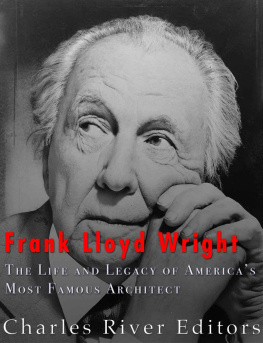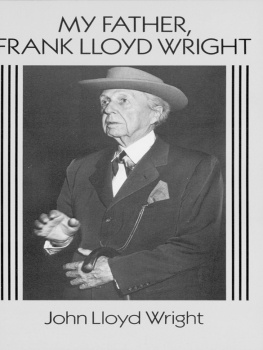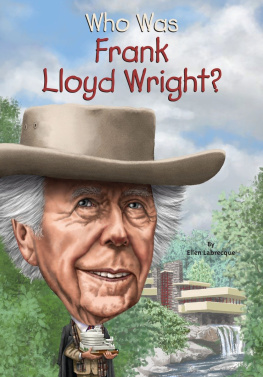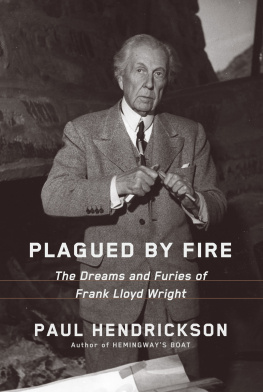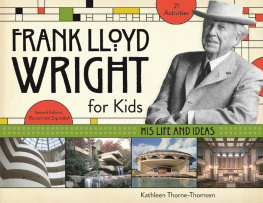Charles River Editors - Frank Lloyd Wright: The Life and Buildings of Americas Most Famous Architect
Here you can read online Charles River Editors - Frank Lloyd Wright: The Life and Buildings of Americas Most Famous Architect full text of the book (entire story) in english for free. Download pdf and epub, get meaning, cover and reviews about this ebook. year: 2016, publisher: Charles River Editors, genre: Non-fiction. Description of the work, (preface) as well as reviews are available. Best literature library LitArk.com created for fans of good reading and offers a wide selection of genres:
Romance novel
Science fiction
Adventure
Detective
Science
History
Home and family
Prose
Art
Politics
Computer
Non-fiction
Religion
Business
Children
Humor
Choose a favorite category and find really read worthwhile books. Enjoy immersion in the world of imagination, feel the emotions of the characters or learn something new for yourself, make an fascinating discovery.
- Book:Frank Lloyd Wright: The Life and Buildings of Americas Most Famous Architect
- Author:
- Publisher:Charles River Editors
- Genre:
- Year:2016
- Rating:3 / 5
- Favourites:Add to favourites
- Your mark:
- 60
- 1
- 2
- 3
- 4
- 5
Frank Lloyd Wright: The Life and Buildings of Americas Most Famous Architect: summary, description and annotation
We offer to read an annotation, description, summary or preface (depends on what the author of the book "Frank Lloyd Wright: The Life and Buildings of Americas Most Famous Architect" wrote himself). If you haven't found the necessary information about the book — write in the comments, we will try to find it.
Frank Lloyd Wright: The Life and Buildings of Americas Most Famous Architect — read online for free the complete book (whole text) full work
Below is the text of the book, divided by pages. System saving the place of the last page read, allows you to conveniently read the book "Frank Lloyd Wright: The Life and Buildings of Americas Most Famous Architect" online for free, without having to search again every time where you left off. Put a bookmark, and you can go to the page where you finished reading at any time.
Font size:
Interval:
Bookmark:
By Charles River Editors

A commemorative Frank Lloyd Wright stamp

Charles River Editors provides superior editing and original writing services across the digital publishing industry, with the expertise to create digital content for publishers across a vast range of subject matter. In addition to providing original digital content for third party publishers, we also republish civilizations greatest literary works, bringing them to new generations of readers via ebooks.
Sign up here to receive updates about free books as we publish them , and visit Our Kindle Author Page to browse todays free promotions and our most recently published Kindle titles.

Frank Lloyd Wright (1867-1959)
The architect must be a prophet... a prophet in the true sense of the term... if he can't see at least ten years ahead don't call him an architect. Frank Lloyd Wright
Perhaps Americas most innovative and prolific architect, the works of Frank Lloyd Wright are almost too vast and diverse to list. Recognized for designing unique churches and distinctive commercial buildings, and admired for his geometric style house designs, Wright has been widely imitated, and his work continues to influence architecture not only in the United States but around the world. Laymen often think they know the definition of a Frank Lloyd Wright, but they probably dont fully understand the brilliant mind of the man, nor the intricacies of his Prairie Style. Yet it endures because he has made it so.
In many ways, Wrights architectural career has overshadowed other aspects of his life. In the course of creating innovative kinds of offices, churches, schools, skyscrapers, hotels, and museums, not to mention furniture and stained glass decorations, Wright wrote over a dozen books and toured America and Europe at large, often giving widely acclaimed speeches. Despite a somewhat hardscrabble start to life in the Midwest, Wright became known for his flamboyant and entertaining lifestyle, which included multiple marriages and scandals like the murders at his Taliesin studio in 1914. But through it all, Wright continued working nearly up until his death, and in 1991 the American Institute of Architects recognized him as "the greatest American architect of all time"
Frank Lloyd Wright: The Life and Buildings of Americas Most Famous Architect looks at the life and works of one of historys greatest builders. Along with pictures of important people, places, and events, you will learn about Frank Lloyd Wright like never before.
Early in life I had to choose between honest arrogance and hypocritical humility. I chose the former and have seen no reason to change. Frank Lloyd Wright
The world-famous architect, Frank Lloyd Wright, was born on June 8, 1867, in Richland Center, Wisconsin Frank Lloyd Wrights grandparents were early arrivals in Ixonia, Wisconsin, when Richard Lloyd-Jones, his wife, and seven children immigrated from Wales to their new home on the Wisconsin prairie. Unlike many immigrants at the time, the Lloyd-Jones family traveled by water from one land to the other, rather than pioneer wagon, first aboard an ocean liner, then via canal boats, followed by a lake-steamer.
But pioneers they were. Richard Lloyd-Jones established a farm in Wisconsin at a time when Native Americans still lived in the Midwest.
In addition to being a farmer, Richard Lloyd-Jones was a Unitarian preacher. He established a Unitarian church in Ixonia where he declared speech was free because men were. Truth was the hallmark of grandpa Lloyd-Jones, as evidenced by the Druid symbol he took for his family crest which stood for Truth against the world. His commitment to truth in all things deeply impacted Frank Lloyd Wrights life, and he spoke of it often.
Richard Lloyd-Joness fourth child, Anna, was only five years old when the family arrived in the United States. She later became Frank Lloyd Wrights mother, making him a first generation Wright.
The familys respect for truth manifested itself in the belief that education was mans salvation. To that end, Anna became a country schoolteacher, riding on horseback to various schoolhouses.
Frank Lloyd Wright failed to inherit his mothers confidence in the educational system. In his autobiography, Wright said, Were I a Rockefeller Ford or Dupont, I mean as rich, I would buy up our leading universitiesclose them and hang out the signclosed by the beneficence of one, Frank Lloyd Wright. That is not to say he did not respect intellect, education, and enlightenment. He simply had less trust in organized education than did his mother.
During her tenure as a country schoolteacher, Anna met a circuit rider from Hartford, Conn., who was traveling through Wisconsin, making his rounds. William Russell Cary Wright was educated at Amherst College where he originally studied medicine before deciding it wasnt for him. Then he studied the law, becoming a circuit-rider and meting out justice in the Midwest.
When Anna and the young William Russell Cary Wright married, they each left their horse-riding days behind.
Anna stopped teaching, and Mr. Wright became a music teacher, but he eventually gave that up as well. Changing occupations yet another time, he became a preacher.
Anna and Williams first child was Frank Lloyd Wright, the grandson of immigrant Richard Lloyd-Jones. According to Frank, his father was jealous of his mothers attention to her newborn son. She predicted that Frank Lloyd Wright was to build beautiful buildings, and she would stop at nothing to make that happen.
Even before he was born Anna had decided that Frank would be an architect. To that end, she decorated his babys room with ten wood-engravings of English cathedrals. The first images the future architect would see were great, celebrated buildings. Frank did become the architect of his mothers dreams, but he detested the gaudy European stone buildings she'd chosen for him. As an adult, he made a career out of helping architecture to evolve in a new and innovative way, changing how buildings of any kind were designed. As far as Wright was concerned, the ornate trim and gargantuan domes were things to be done away with.
Three years later, the Wright family welcomed a baby girl, little Jane Wright. At about the same time, the now Reverend William Russell Cary Wright was called to a church at Weymoth, near Boston. As a result, Frank and Jane spent their first few years in a Boston suburb, far from the familys Wisconsin home. But it was a Baptist church, and very much in contrast to the Unitarian teachings Frank had previously learned from his mother and her family.
It was while the family lived in Boston that Anna Lloyd-Jones Wright discovered Friedrich Froebel's concept of kindergarten, which was a new and foreign concept to her. Anna decided her very young children would benefit from Froebels approach. She discovered that, in the United States, Milton Bradley had embraced Froebels concept, well before kindergarten had become a part of the American school system, and had begun to manufacture learning products. Milton Bradley created blocks of different shapes with which to teach basic skills, and called them Kindergarten Gifts. Anna Wright eagerly bought these Kindergarten Gifts in order to teach preschoolers Frank and Jane, but as far as Anna was concerned, there never seemed to be enough education, so Frank also attended Miss Williams private school, a fashionable school in the Boston suburbs, for some years.
Font size:
Interval:
Bookmark:
Similar books «Frank Lloyd Wright: The Life and Buildings of Americas Most Famous Architect»
Look at similar books to Frank Lloyd Wright: The Life and Buildings of Americas Most Famous Architect. We have selected literature similar in name and meaning in the hope of providing readers with more options to find new, interesting, not yet read works.
Discussion, reviews of the book Frank Lloyd Wright: The Life and Buildings of Americas Most Famous Architect and just readers' own opinions. Leave your comments, write what you think about the work, its meaning or the main characters. Specify what exactly you liked and what you didn't like, and why you think so.

